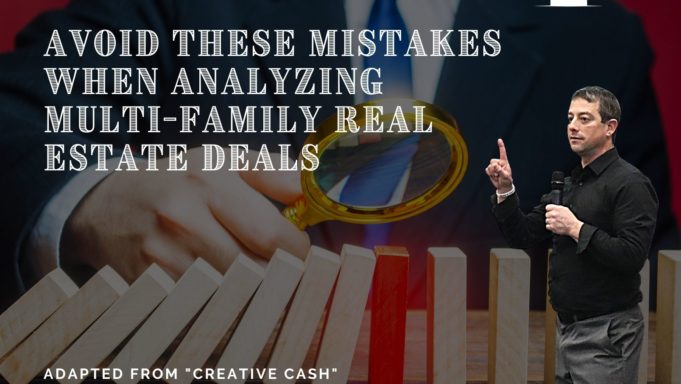
Avoid These Mistakes When Analyzing Multi-family Real Estate Deals
The following is adapted from Creative Cash by Bill Ham, Gino Barbaro, and Jake Stenziano.
Analysis is key with creative and seller financing (CSF), a type of financing that doesn’t fall into the traditional form of lending by banks. Analysis isn’t that exciting, but when you spend your time and attention on it, you’ll reap the rewards that come from good real estate deals.
If you’re just starting out with multi-family real estate and CSF you will likely make some mistakes in your search for good deals—and these mistakes can cost you a lot of money, which is something you definitely want to avoid. Luckily for you, I’ve made many mistakes, and I’m going to share them with you here so you don’t have to suffer the consequences.
Know Your Market and Occupancy
When you begin valuing a deal, you’ll want to look very closely at the market surrounding your property. You can lose big if you don’t know your market. It almost happened to me but it ended up okay only because I bought for cash flow, not for sale value. If I bet on selling at a profit, I would have gone into foreclosure with that deal.
You also need to find out the average occupancy of comparable properties in your area. If you look at an apartment deal and see that occupancy is 70 percent and you will cash flow at 85 percent, getting those units rented is a value play for this deal. If you look within a 3 to 5 mile radius and all the properties in the area are at 70 percent occupancy, then this is not a value play at all: it’s the market! Remember, you can rehab a property, but you cannot rehab a market.
Watch this video as well:
Check Out the Competition and the Amenities
Don’t look at a property with two-bed units and then look at other properties with three-bed units and simply compare the rents. Other properties may charge more for a two-bed unit than you are, but if they have bigger units, then increasing your rent is not a value play. It will make you less competitive in the area. Compare price per square foot (total rentable square feet divided by the rent) to make sure you are competitive with your rents.
The more amenities you have, the more you can charge for rent. Make sure when you compare rents you also consider the value of your competitor’s amenities. If they have a pool and you don’t, they can charge more in rent for a similarly sized unit.
Get to Know the Neighborhood
You should never buy a property in an area that you don’t understand. This is easy to say but hard to do. I suggest you really get to know an area before doing business there. Low-income areas tend to be harder to manage, but high-income areas tend to be more expensive.
You’ll need to find a balance between what you can afford to get into and what you can afford to deal with. A Master Lease Option (MLO) may allow you to get into a deal easier than if you bought it outright, but you must keep in mind that you still have to deal with it day in and day out. If you wouldn’t spend the night on your property, then you probably shouldn’t own or manage it.
Getting the Cash Back
When you look at the value of a property, you need to look at the terms by which you will take control of the deal. The agreement you strike with the seller can affect the value as much as anything else. Try to figure out how many months it will take to cash flow back your option money. If their answer is that you won’t get it back or that it may take most of the contract time to recover your money, then you need to reduce the value of that deal considerably.
In general, the terms can make or break a deal. You may have a great property that cash flows a lot of money, but if the seller will only accept an MLO offer contingent upon them getting almost all of the income, then it’s not a good deal, regardless of the property. Likewise, if you have a deal that makes less income but the seller defers a year’s worth of payments or doesn’t require any option money at all, then the value is higher.
Analysis is the Key to Avoid Mistakes
Avoiding mistakes comes with spending time on analysis.
Most people think building a real estate business or portfolio consists of driving around and looking at deals, meeting realtors, and high-profile closings. An exceedingly small percentage of your time will be spent doing these tasks. Money in real estate is made on spreadsheets, not at the closing table.
Finding deals, and avoiding the mistakes that can come with them, is about how you analyze a multifamily deal. Deal analysis is about long hours in front of a computer, looking at financial statements and creating pro formas. Sound boring? It is, but it pays.
Become a true master at analyzing and identifying profitable multifamily deals both quickly and accurately. The Deal Analyzer is an online suite that consists of 6 powerful and easy to use calculators to help breakdown and analyze numbers like a real investing pro! You’ll get access to all 6 calculators that include: Deal Analyzer, Net Worth, Budget, Schedule of Real Estate Owned, Lease Audit and Apartment Turn. These calculators will save you time, make you money, and put you on the fast track to future success!
For more advice on analyzing multi-family real estate deals, you can find Creative Cash on Amazon.
What started out as a conversation at a live event one hot, sunny day in downtown Atlanta has blossomed into an amazing collaboration between Bill Ham, Jake Stenziano, and Gino Barbaro (Jake & Gino). Bill was instrumental in helping Jake & Gino launch their mentoring program and is one of the lead trainers in the company. With over twenty-five years of experience in operating vertically integrated real estate businesses, and over $100 million in assets under management, Bill, together with Jake & Gino, strive to teach others the strategies that have allowed them to become financially free.







